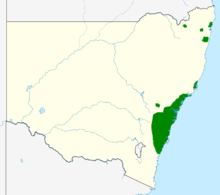
Back Lambertia formosa CEB Lambertia formosa Spanish Diable de montagne French Lambertia formosa ID Lambertia formosa Swedish Lambertia formosa Turkish Lambertia formosa WAR
| Lambertia formosa | |
|---|---|

| |
| Scientific classification | |
| Kingdom: | Plantae |
| Clade: | Tracheophytes |
| Clade: | Angiosperms |
| Clade: | Eudicots |
| Order: | Proteales |
| Family: | Proteaceae |
| Genus: | Lambertia |
| Species: | L. formosa
|
| Binomial name | |
| Lambertia formosa | |

| |
| Range of L. formosa | |
| Synonyms[1] | |
Lambertia formosa, commonly known as mountain devil, is a shrub of the family Proteaceae, endemic to New South Wales, Australia. First described in 1798 by English botanist James Edward Smith, it is the type species of the small genus Lambertia. It is generally found in heathland or open forest, growing in sandstone-based soils. It grows as a multistemmed shrub to around 2 m (7 ft) with a woody base known as a lignotuber, from which it regrows after bushfire. It has stiff narrow leaves, and the pink to red flowerheads, made up of seven individual tubular flowers, generally appear in spring and summer. It gains its common name from the horned woody follicles, which were used to make small devil-figures.
The flowers hold profuse amounts of nectar and are pollinated by honeyeaters. Although L. formosa is uncommon in cultivation, it is straightforward to grow in soils with good drainage and a partly shaded to sunny aspect. It is readily propagated by seed. Unlike all other members of the genus Lambertia, L. formosa is greatly resistant to the soil pathogen Phytophthora cinnamomi.
- ^ a b "Lambertia formosa". Australian Plant Name Index (APNI), IBIS database. Centre for Plant Biodiversity Research, Australian Government. Retrieved 3 March 2013.
© MMXXIII Rich X Search. We shall prevail. All rights reserved. Rich X Search